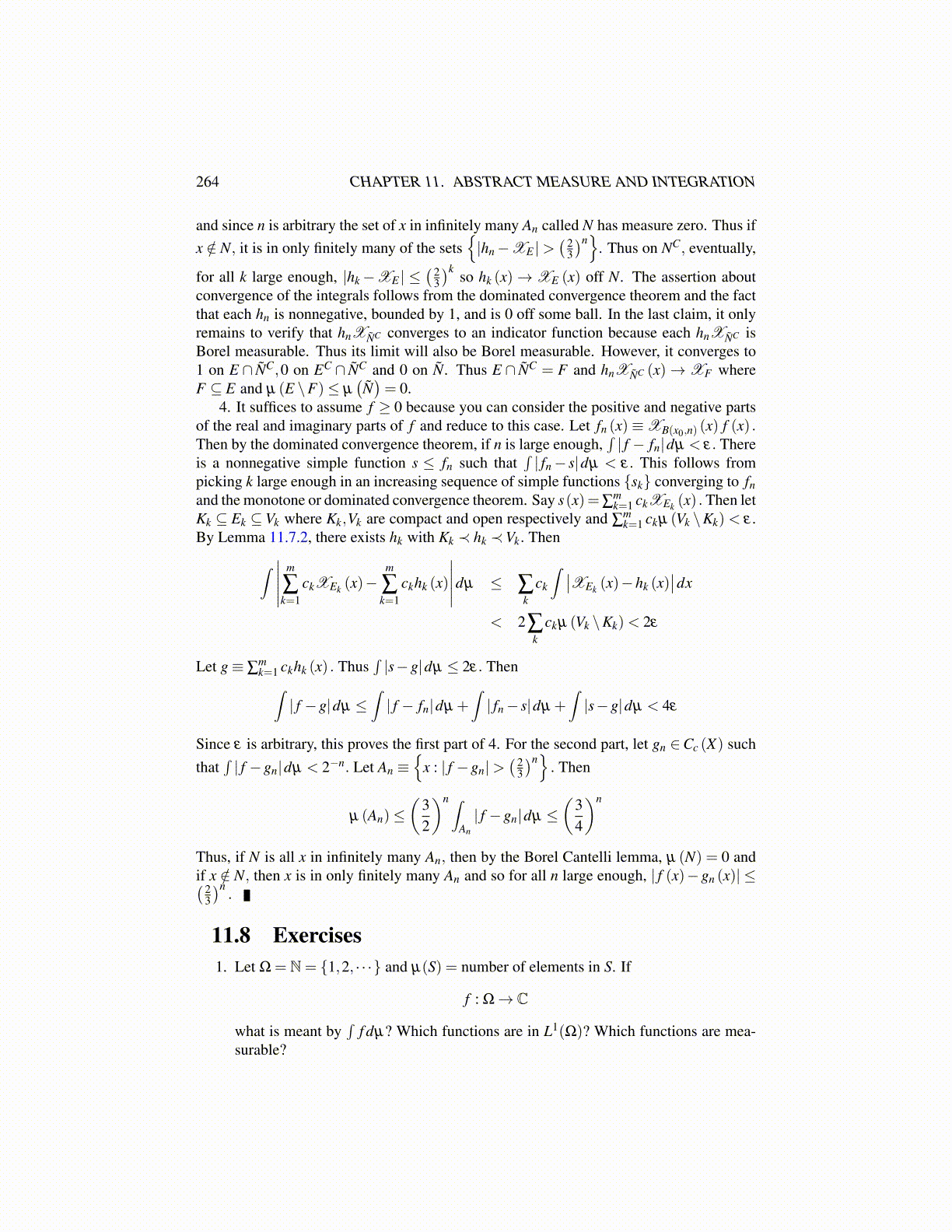
264 CHAPTER 11. ABSTRACT MEASURE AND INTEGRATION
and since n is arbitrary the set of x in infinitely many An called N has measure zero. Thus ifx /∈ N, it is in only finitely many of the sets
{|hn−XE |>
( 23
)n}
. Thus on NC, eventually,
for all k large enough, |hk−XE | ≤( 2
3
)kso hk (x)→XE (x) off N. The assertion about
convergence of the integrals follows from the dominated convergence theorem and the factthat each hn is nonnegative, bounded by 1, and is 0 off some ball. In the last claim, it onlyremains to verify that hnXÑC converges to an indicator function because each hnXÑC isBorel measurable. Thus its limit will also be Borel measurable. However, it converges to1 on E ∩ ÑC,0 on EC ∩ ÑC and 0 on Ñ. Thus E ∩ ÑC = F and hnXÑC (x)→XF whereF ⊆ E and µ (E \F)≤ µ
(Ñ)= 0.
4. It suffices to assume f ≥ 0 because you can consider the positive and negative partsof the real and imaginary parts of f and reduce to this case. Let fn (x)≡XB(x0,n) (x) f (x) .Then by the dominated convergence theorem, if n is large enough,
∫| f − fn|dµ < ε. There
is a nonnegative simple function s ≤ fn such that∫| fn− s|dµ < ε. This follows from
picking k large enough in an increasing sequence of simple functions {sk} converging to fnand the monotone or dominated convergence theorem. Say s(x)=∑
mk=1 ckXEk (x) . Then let
Kk ⊆ Ek ⊆Vk where Kk,Vk are compact and open respectively and ∑mk=1 ckµ (Vk \Kk)< ε .
By Lemma 11.7.2, there exists hk with Kk ≺ hk ≺Vk. Then
∫ ∣∣∣∣∣ m
∑k=1
ckXEk (x)−m
∑k=1
ckhk (x)
∣∣∣∣∣dµ ≤ ∑k
ck
∫ ∣∣XEk (x)−hk (x)∣∣dx
< 2∑k
ckµ (Vk \Kk)< 2ε
Let g≡ ∑mk=1 ckhk (x) . Thus
∫|s−g|dµ ≤ 2ε. Then∫
| f −g|dµ ≤∫| f − fn|dµ +
∫| fn− s|dµ +
∫|s−g|dµ < 4ε
Since ε is arbitrary, this proves the first part of 4. For the second part, let gn ∈Cc (X) suchthat
∫| f −gn|dµ < 2−n. Let An ≡
{x : | f −gn|>
( 23
)n}. Then
µ (An)≤(
32
)n ∫An
| f −gn|dµ ≤(
34
)n
Thus, if N is all x in infinitely many An, then by the Borel Cantelli lemma, µ (N) = 0 andif x /∈ N, then x is in only finitely many An and so for all n large enough, | f (x)−gn (x)| ≤( 2
3
)n.
11.8 Exercises1. Let Ω = N= {1,2, · · ·} and µ(S) = number of elements in S. If
f : Ω→ C
what is meant by∫
f dµ? Which functions are in L1(Ω)? Which functions are mea-surable?